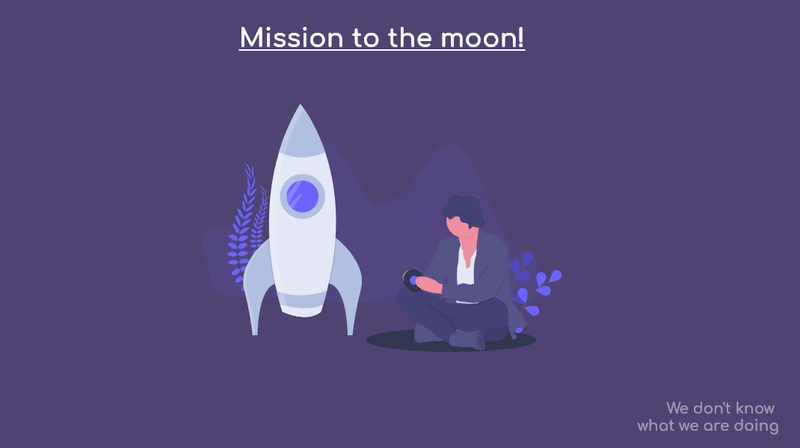We Don't Know What We Are Doing | Mission to the Moon!
Awards & Nominations
We Don't Know What We Are Doing has received the following awards and nominations. Way to go!
The Challenge | Mission to the Moon!
Conquering South Pole of the Moon with Mission Planner!
Planning mission to the south pole of the Moon with hand-crafted simulator named “Mission Planner”.

Repository of cosmic knowledge shrouded in darkness. Lunar south pole is holding its secrets tight in the most unwelcome conditions. Uncovering its mysteries will require a well tested and optimized plan. Using MISSION Planner app we are able to simulate rover mission and predict the best possible scenario to minimize risks and maximize outcomes. Simulation is taking into account terrain features, energy management and vehicle maneuverability.
Motivation
In the collective consciousness of many people, Moon seems to be well known and explored astronomical object. Man set foot on it over 49 years ago and from that time attention of humanity is focusing on Mars, gradually losing interest in earth natural satellite. But Luna still have very much to offer, including answers to the most dire existential question - How universe was created.
Such answers can be found within the forever dark craters of the lunar south pole. There we can suspect to find fossil records as old as the universe itself and even pockets of ice!
That kind of possibilities stirred our imagination with an idea of exploratory mission.
Sadly, exploration of the most valuable side of the moon is difficult, mostly because of the uneven sunlight exposure and hilly landscape. Deep craters and high hills are obstacles which must be avoided in order to reach destination without the risk of rover immobilization. Also lack of sunlight is shortening the time of rover activity due to the inability to recharge battery using solar power.
Such problems cannot stop a group of young engineers. That’s why we decided to start planning our mission by… creating moon mission simulator.
Mission Planner
Why making a planner something complicated? We are all familiar with apps that help us go to the destination point such as Google Maps. If our rover needs to visit specific locations and get there by optimal path, why not make a similar tool, but for the moon?

The core of our simulator is the data. We used images from Lunar Reconnaissance Orbiter Camera to learn about moon's terrain. Based on that we were able to visualize luna’s topography in 3D and later create a weighted graph that will be crucial to our algorithm.
Once the graph was created we wanted to make sure that we are minimizing risk of rover immobilization. This is why weights in our graph were precisely chosen to punish our rover when it is trying to climb steep hills.
The actual input to our Mission Planner is a set of points that the rover needs to visit to complete its mission. Using our weighted graph we were then able to use our algorithm and search for the most optimal path given our mission objectives.


At last we are visualizing our moon’s terrain map along with the optimal path for our current objectives. We are also providing feedback about mission results: total time, total distance, battery usage, collected samples and hypsometric profile.

Future
In the future we would like to extend parameters set of our mission simulation. For example:
- battery capacity,
- power consumption and its characteristics,
- maximum speed,
- maximum slope that rover can climb,
- date and time of our mission for possible solar battery charging,
- support for regenerative braking system.

Also, our application can be extended to find the perfect place for landing. We can take all mission goals and use terrain structure to predict where we can land.
Resources
- http://moon.nasa.gov
- http://lroc.sese.asu.edu
- https://www.jpl.nasa.gov
- https://www.nasa.gov/moon
- Genta, G. (2012). Introduction to the Mechanics of Space Robots. Springer Netherlands
SOURCE CODE
Github: Github Team Organization
SpaceApps is a NASA incubator innovation program.